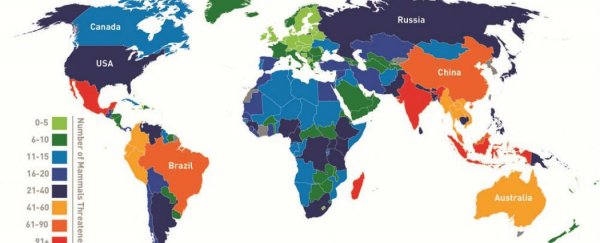At least once each year, the International Union for Conservation of Nature updates its Red List of Threatened Species to keep tabs on which animals in the world are at risk of extinction.
The news isn't good. The IUCN estimates that 26 percent of the world's mammals are threatened, meaning scientists evaluated them to be critically endangered, endangered, or vulnerable. But this is just the IUCN's best estimate - the environmental organisation says the percentage of threatened mammal species could be as low as 22 percent (still bad) or as high as 37 percent (let's hope not).
Where in the world do these threatened mammals live? Take a look at the map above.
The map, put together with data from the World Bank, shows the four countries with over 90 threatened mammal species in red: Indonesia (184), Madagascar (114), Mexico (101), and India (94).
Indonesia
IUCN data says Indonesia hosts 670 mammal species, more than any other country in the world. The island nation also has the highest rates of deforestation in the world, according to a report published in Nature Climate Change in 2014.
That deforestation destroys the homes of many mammals, leading to population decline. It also separates them from other groups of their species, driving the dwindling populations to inbreeding.
That combination puts a lot of mammals at risk, including the Bornean Orangutan, which has been listed as endangered since 2000. The orangutan is losing its forest habitat as people cut down trees for timber and to convert the forest to farms. Poaching and people capturing orangutans for pets are also decreasing the number of orangutans in the wild.
Madagascar
Like Indonesia, Madagascar has high biodiversity. There are 111 threatened mammal species endemic to Madagascar, meaning they're found no where else in the world but this island with an area slightly less than twice the size of Arizona.
One of those endemic mammals, the Black-and-white Ruffed Lemur, is listed as critically endangered because of habitat loss and unsustainable hunting. They're big and active during the day, which makes them one of the species of lemur humans hunt the most for food.
Mexico
Habitat loss from human encroachment is a distressingly common theme - the IUCN says it's the greatest threat to mammals all over the world. Baird's Tapir, listed as endangered in Mexico, is no exception. The scientists who reported on the tapir to IUCN estimated that at least 50 percent of the animal's habitat throughout Central America was lost in the past 33 years.
The tapir is also at a disadvantage biologically, because it takes them so long to reproduce. Tapir mothers carry one baby for 13 months, then care for that baby up to two years after its birth. That means the population doesn't grow very fast, making it even more difficult for tapirs to cope with habitat loss and hunting.
India
In addition to causing habitat loss, when humans move into spaces where animals live, it increases the frequency of conflicts between humans and animals, which further threatens animal populations. In India, for example, endangered Asian Elephants eat or trample crops growing in what used to be their habitat before humans took over the land for agriculture.
Not only are elephants losing their habitat, but hundreds also die in clashes with people who don't want the elephants to eat their crops (and the conflicts don't end well for people either). According to the IUCN, addressing conflicts between humans and elephants in Asia is one of today's largest conservation challenges.
For a closer look at where the most mammal species are threatened, check out the map with breakdowns by continent:
 Credit: The Eco Experts, data from the World Bank
Credit: The Eco Experts, data from the World Bank
This article was originally published by Business Insider.
More from Business Insider:
